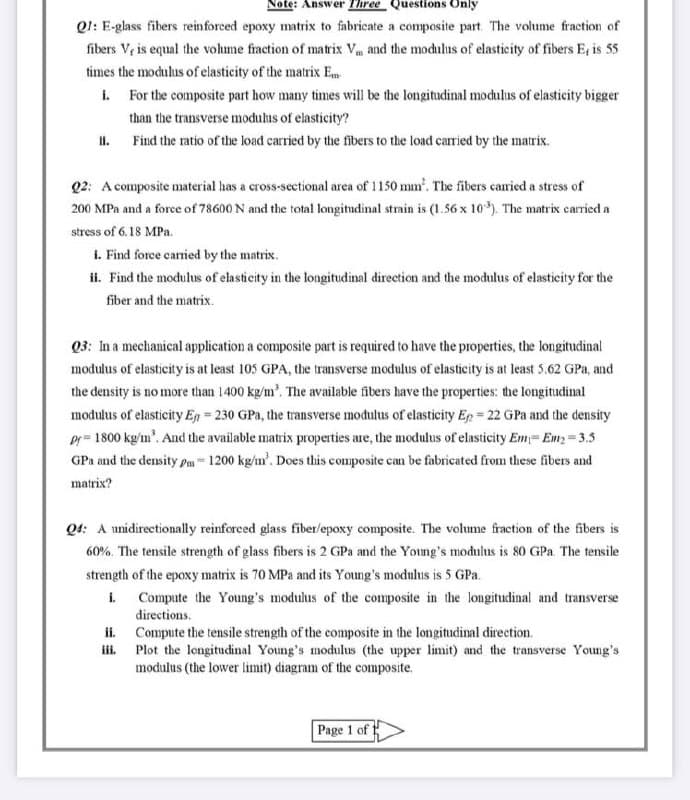Q1: E-glass fibers reinforced epoxy matrix to fabricate a composite part. The volume fraction of fibers V, is equal the volume fraction of matrix V. and the modulus of elasticity of fibers E, is 55 times the modulus of elasticity of the matrix E i. For the composite part how many times will be the longitudinal modulus of elasticity bigger than the transverse modulus of elasticity? II. Find the ratio of the load carried by the fibers to the load carried by the matrix.
Q1: E-glass fibers reinforced epoxy matrix to fabricate a composite part. The volume fraction of fibers V, is equal the volume fraction of matrix V. and the modulus of elasticity of fibers E, is 55 times the modulus of elasticity of the matrix E i. For the composite part how many times will be the longitudinal modulus of elasticity bigger than the transverse modulus of elasticity? II. Find the ratio of the load carried by the fibers to the load carried by the matrix.
Elements Of Electromagnetics
7th Edition
ISBN:9780190698614
Author:Sadiku, Matthew N. O.
Publisher:Sadiku, Matthew N. O.
ChapterMA: Math Assessment
Section: Chapter Questions
Problem 1.1MA
Related questions
Question

Transcribed Image Text:Note: Answer Three Questions Only
Q1: E-glass fibers reinforced epoxy matrix to fabricate a composite part. The volume fraction of
fibers V, is equal the volume fraction of matrix V. and the modulus of elasticity of fibers E, is 55
times the modulus of elasticity of the matrix Em
i.
For the composite part how many times will be the longitudinal modulus of elasticity bigger
than the transverse modulus of elasticity?
11.
Find the ratio of the load carried by the fibers to the load carried by the matrix.
Q2: A composite material has a cross-sectional area of 1150 mm². The fibers carried a stress of
200 MPa and a force of 78600 N and the total longitudinal strain is (1.56 x 10³). The matrix carried a
stress of 6.18 MPa.
i. Find force carried by the matrix.
ii. Find the modulus of elasticity in the longitudinal direction and the modulus of elasticity for the
fiber and the matrix.
Q3: In a mechanical application a composite part is required to have the properties, the longitudinal
modulus of elasticity is at least 105 GPA, the transverse modulus of elasticity is at least 5.62 GPa, and
the density is no more than 1400 kg/m³. The available fibers have the properties: the longitudinal
modulus of elasticity En=230 GPa, the transverse modulus of elasticity E= 22 GPa and the density
pr=1800 kg/m³. And the available matrix properties are, the modulus of elasticity Em-Em₂ = 3.5
GPa and the density pm - 1200 kg/m³. Does this composite can be fabricated from these fibers and
matrix?
Q1: A unidirectionally reinforced glass fiber/epoxy composite. The volume fraction of the fibers is
60%. The tensile strength of glass fibers is 2 GPa and the Young's modulus is 80 GPa. The tensile
strength of the epoxy matrix is 70 MPa and its Young's modulus is 5 GPa
i.
Compute the Young's modulus of the composite in the longitudinal and transverse
directions.
ii.
Compute the tensile strength of the composite in the longitudinal direction.
iii.
Plot the longitudinal Young's modulus (the upper limit) and the transverse Young's
modulus (the lower limit) diagram of the composite.
Page 1 of 1
Expert Solution
This question has been solved!
Explore an expertly crafted, step-by-step solution for a thorough understanding of key concepts.
Step by step
Solved in 3 steps

Knowledge Booster
Learn more about
Need a deep-dive on the concept behind this application? Look no further. Learn more about this topic, mechanical-engineering and related others by exploring similar questions and additional content below.Recommended textbooks for you

Elements Of Electromagnetics
Mechanical Engineering
ISBN:
9780190698614
Author:
Sadiku, Matthew N. O.
Publisher:
Oxford University Press

Mechanics of Materials (10th Edition)
Mechanical Engineering
ISBN:
9780134319650
Author:
Russell C. Hibbeler
Publisher:
PEARSON

Thermodynamics: An Engineering Approach
Mechanical Engineering
ISBN:
9781259822674
Author:
Yunus A. Cengel Dr., Michael A. Boles
Publisher:
McGraw-Hill Education

Elements Of Electromagnetics
Mechanical Engineering
ISBN:
9780190698614
Author:
Sadiku, Matthew N. O.
Publisher:
Oxford University Press

Mechanics of Materials (10th Edition)
Mechanical Engineering
ISBN:
9780134319650
Author:
Russell C. Hibbeler
Publisher:
PEARSON

Thermodynamics: An Engineering Approach
Mechanical Engineering
ISBN:
9781259822674
Author:
Yunus A. Cengel Dr., Michael A. Boles
Publisher:
McGraw-Hill Education

Control Systems Engineering
Mechanical Engineering
ISBN:
9781118170519
Author:
Norman S. Nise
Publisher:
WILEY

Mechanics of Materials (MindTap Course List)
Mechanical Engineering
ISBN:
9781337093347
Author:
Barry J. Goodno, James M. Gere
Publisher:
Cengage Learning

Engineering Mechanics: Statics
Mechanical Engineering
ISBN:
9781118807330
Author:
James L. Meriam, L. G. Kraige, J. N. Bolton
Publisher:
WILEY